To effectively combat acne, it is not enough to know a good dermatologist and acquire an arsenal of special cosmetics. Ideally, it is better to prevent a problem, and to do this you need to be aware of its causes.
- Causes of acne
- Acne map on face
- Determining the severity of the disease
- Preventive measures to combat acne
- Tools Overview
Causes of acne
Not so long ago, recurrent acne on the face received the status of a disease called “acne”, or “acne disease”. The attitude towards them has also become more serious, not just as a local cosmetic defect.
A pimple is an inflammatory element. The process of inflammation is associated with the sebaceous gland. When the outflow of sebum is disrupted for some reason, the ducts of the sebaceous glands become clogged, and acne propionbacteria begin to multiply in them.
To date, several factors have been studied that provoke disruption of the outflow of sebum and inflammation of the sebaceous glands.
Floury, sweet and fatty foods are often the causes of acne © iStock
Poor nutrition
Flour, sweets, and fatty foods are blamed for the appearance of acne - however, these three can be blamed for almost any health problem. Indeed, if you remove these foods from your diet, your skin will become noticeably clearer.
Prevention of rashes includes a healthy, balanced diet and the presence of essential vitamins in the diet. In particular, vitamins A, C, group B. To compensate for the deficiency of useful substances, you can take them in tablets or capsules.
Illiterate care
Oily skin is especially prone to increased activity of the sebaceous glands. That is why she needs products designed specifically for her. Cosmetics for other skin types will not be suitable - they are not able to remove excess fat, if we are talking about cleansing and moisturizing properly (to normalize sebum production).
The ducts of the sebaceous glands become clogged with excess sebum, which mixes with dead epidermal cells, particles of makeup, and everyday pollution. In this regard, when caring for oily skin, special emphasis should be placed on cleansing.
Obviously, touching your face with dirty hands or using unwashed brushes for cosmetics means provoking acne.
Hormonal imbalance
To combat acne, products based on zinc, salicylic acid, and clay are produced. © iStock
And if estrogens (female sex hormones) suppress the production of sebum, then androgens (male hormones), on the contrary, stimulate it. In addition, the point is not so much in the excess of androgens, but in the sensitivity of the sebaceous gland receptors to them. Therefore, with the same hormone levels, one person will have acne and another will not.
Acne in a woman after 20-30 years is a reason to visit a gynecologist and endocrinologist.
Diseases
These are mainly problems with the gastrointestinal tract. If there are problems with digestion (including as a result of poor nutrition), the balance of microflora is disrupted. This also affects the condition of the skin.
Digestive disorders lead to an excess of toxins in the gastrointestinal tract, from where they enter the bloodstream and can negatively affect the condition of the skin, contributing to the occurrence of inflammation.
Emotional condition
For a person with problem skin, stress is a powerful risk factor. The pimple pops up at the most crucial moment, because this moment is associated with emotions and excitement.
“It is known that the stress hormone cortisol provokes increased production of sebum and, as a result, clogged pores,” explains Vichy brand expert Elena Eliseeva.
For the same reason, the connection between deteriorating skin quality and lack of sleep becomes clear. Lack of sleep is also stressful for the body.
Stress and lack of sleep often trigger rashes. Avoid both. © iStock
Climatic factor
Subcutaneous mite
Demodex (subcutaneous mite) is a rather controversial cause of acne. It lives in the skin of 80% of people, but begins to cause trouble, including acne, only against the background of additional health problems or allergies to its waste products.
Acne map on face
Most often, the localization of the rash indicates that it is in this area that the sebaceous gland receptors are very sensitive to the effects of hormones. It is believed that the location of the rash can determine the nature of the problems in the body. In fact, dermatologists do not support this theory, but for general information we will still write about it.
“Favorite” places for acne to appear are the forehead, nose, and chin. © iStock
Part of the so-called T-zone. There are many sweat and sebaceous glands located here, so the skin is often characterized by increased oiliness. It is believed that rashes on the forehead indicate diseases of the large and small intestines.
In adolescence, acne on the cheeks predominates in boys. If acne appears in this area in women, it makes sense to check the hormonal system and intestines.
The nose is also part of the T-zone, where there are many sebaceous and sweat glands.
Here, acne no longer appears in adolescence, but after 30. They are usually associated with hormonal disorders and gynecological problems.
Determining the severity of the disease
The more rashes and inflammations, the more severe the disease. If we are not talking about single pimples, you should consult a dermatologist.
Preventive measures to combat acne
Clear skin for people whose skin is prone to breakouts is the result of careful daily care. It looks something like this.
Cleansing using a special product: it will remove excess sebum, impurities, and makeup.
Washing using gel or foam for oily or problem skin and toning. Once or twice a week, deep cleansing using clay-based masks is recommended (an approximate scheme for such cleansing is given below).
Hydration – a mandatory step in caring for oily skin. Lack of moisture provokes increased production of sebum. Due to the use of aggressive cleansers, oily skin often becomes dehydrated. It urgently needs moisture to maintain hydrolipid balance. Moisturizing normalizes sebum secretion, which helps fight inflammation and infection.
Camouflage imperfections using foundation, corrector or powder designed specifically for problem skin.
© skin.ru
Tools Overview
Acne prevention program. Cleansing
As a cleansing gel, it cleanses and mattifies the skin. If used as a scrub, it exfoliates and prevents pore clogging. As a mask, it deeply cleanses pores and visually tightens them (apply for 3 minutes, rinse with warm water).
eucalyptus extract, salicylic acid, zinc
Suitable for pre-cleansing before washing: removes makeup, removes impurities.
Completes the cleansing process and tightens pores.
salicylic acid, zinc
Deeply cleanses problematic skin.
two types of mineral clay, thermal water with selenium
Cleanses the skin of excess sebum and impurities, reduces blackheads, pimples and their marks.
charcoal, salicylic acid, blueberry extract
Exfoliates the skin, effectively cleanses pores, prevents the appearance of acne and fights existing ones.
charcoal, salicylic acid, blueberry extract
Dysfunction of the sebaceous glands and their various diseases are most often observed in young people. These disorders manifest themselves in most cases in the form of acne on the face, skin of the back and chest. This unpleasant fact not only spoils the appearance, but also causes severe discomfort to their owners.

Causes of acne.
There are quite a lot of factors that contribute and directly lead to their appearance. The most common cause is considered to be hormonal surges (hormonal imbalance), which are especially pronounced in young people during puberty (the level of androgens in the blood increases), as well as in women during the premenopausal period.
Insufficient (not regular washing and cleansing of the skin, clogged pores) or improper skin care (incorrectly selected cosmetics, abuse of scrubs and skin cleansing procedures) during puberty can also cause acne. In most cases, this problem is typical for those with oily facial skin, so it is necessary to be very careful when choosing care products for such skin. During the hot season, excessive use of oil-based skincare products and decorative cosmetics (foundation, powder) can also worsen the condition of the skin and cause acne, because when mixed with dirt, dust and sweat, cosmetics clog pores, forming so-called blackheads. As a result, in summer it is recommended to use light, moisturizing and mattifying products that do not clog pores.
Another factor that contributes to the appearance of facial acne is the increase in steroid hormone levels before the onset of menstruation.
Hyperkeratosis or an increase in the upper stratum corneum of the skin due to pressure or friction of the skin, lack of vitamin A, negative effects of petroleum products on the skin, and hormonal pressure can also cause acne on the skin.
Acne may indicate diseases or problems in the gastrointestinal tract due to an unbalanced and unhealthy diet. When acne appears, as well as to prevent its occurrence, it is necessary to limit the consumption of foods such as cheese, coffee, flour and confectionery products.
Lipid metabolism disorders, as well as hereditary predisposition, complement the list of reasons causing the appearance of acne on the face. An equally significant role in this process belongs to the mental state of the body. Excessive fatigue, frequent stressful situations, nervous overexcitation also negatively affect the condition of the skin.
Adverse environmental factors also contribute to skin problems.
One of the causes of pustular rashes on the skin is chronic intoxication of the body. Therefore, in addition to local treatments for acne, it is imperative to cleanse the body of toxins using Enterosgel. This modern drug based on bioorganic silicon effectively absorbs and removes toxic substances from the stomach and intestines, without interacting in any way with the mucous membrane of the gastrointestinal tract. The drug does not cause constipation, does not cause allergies, and does not affect beneficial microflora, unlike other sorbents. Let's take it in long courses.
How to get rid of acne on your face.
Getting rid of acne is quite difficult; this process requires a lot of effort, time, patience, as well as compliance with the rules for caring for problem skin. The success of therapy depends on the degree of skin damage. Mild acne can be eliminated at home with high-quality and regular care using traditional medicine. The severity of the disease can be determined by a simple calculation: if there are less than ten pimples on one side of the face, then this is a mild form that can be easily cured on your own. If the number of acne is much more than ten, in this case you should visit a dermatologist, who, after identifying the cause that led to the development of acne, will recommend the optimal course of treatment and give the necessary recommendations.
In the treatment of mild acne, skin care is key. Every day, morning and evening, the skin must be cleansed, toned, moisturized (day) and nourished (at night), because treatment should be carried out only on cleansed skin. Washing gels, foams, and creams are suitable for cleansing problem skin. Specially developed tonics are perfect for toning; by the way, they can be prepared at home using medicinal plants. After this, the skin needs to be moisturized, for which a cream or hydrogel is ideal. In the evening, the skin especially needs to be cleansed of accumulated impurities, which form a suitable environment for the proliferation of bacteria, and, as a result, the appearance of acne. Caring for problem skin and keeping it healthy is not easy, but it also has its advantages: thanks to its excellent protective function, this type retains youth for the longest time, moisture is retained in the epidermis. Oily shine and fairly visible large pores can be leveled out with the help of careful care and specially developed cosmetic and therapeutic products (masks, peelings, scrubs, drying creams, etc.). The care program for such skin must include masks with a soothing and cleansing effect.
Dermatologists recommend a responsible approach to choosing products to combat acne. Firstly, they must not just eliminate symptoms, but act on the cause, secondly, have a quick and lasting therapeutic effect and, thirdly, be as safe as possible. Recently, experts are increasingly advising the use of combined topical preparations, for example, Klenzit S. Thanks to its gel consistency, the drug penetrates deep into the inflammation, and its constituents, adapalene and clindamycin, have an anti-inflammatory and bactericidal effect, providing a noticeable result.
In addition to careful skin care, a healthy lifestyle, physical activity, and proper and balanced nutrition are important. Diet in the treatment of acne is of particular importance, because it is the elimination of the internal causes of their appearance, first of all, it normalizes the functioning of the sebaceous glands. It is necessary to exclude from the diet sweet, spicy, salty, fatty and spicy foods, alcohol, carbonated and sweet drinks, chips, as well as foods rich in proteins. Instead, eat more fresh fruits and vegetables, cereals, dairy products, seafood and lean meats (turkey, chicken, rabbit).
Why shouldn't you squeeze out pimples on your face?
Never squeeze out pimples on your face yourself! If this is done, then only in a beauty salon under conditions of absolute sterility. Such a procedure, carried out independently, can, at best, lead to the appearance of even more acne due to the introduction and spread of infection, and at worst, to the appearance of unsightly scars, spots and cicatrices, which will be much more difficult to get rid of, and sometimes simply impossible, because constant squeezing injures and irritates the skin. And in the absence of proper treatment, the wounds at the site of acne heal with the formation of scars. ARGOSULFAN® cream helps speed up the healing of abrasions and small wounds. The combination of the antibacterial component silver sulfathiazole and silver ions provides a wide range of antibacterial effects of the cream. The drug can be applied not only to wounds located on open areas of the body, but also under bandages. The product has not only a wound-healing, but also an antimicrobial effect, and in addition, promotes wound healing without a rough scar 1.
In this case, it is necessary to cleanse and treat the rash with creams and gels, but do not apply pressure. Today there are many effective products that perfectly remove redness on the second day of use, and eliminate pimples after a few more days.
Cosmetics for acne.
Effective cosmetics for the care of problem skin should include zinc oxide, witch hazel and chamomile extracts, salicylic acid, triclosan, alpha hydroxyl acids (AHAs), as well as vitamins A, B and C and green tea extract.
Special products for acne treatment.
To treat acne, specialists can prescribe effective medications or ointments. Among the most frequently prescribed are:
- Tretinoin (Airol, Retin A) - the drug is aimed at reducing the functioning of the sebaceous glands and suppressing the activity of bacteria that cause acne. The drug should be applied to the cleansed surface of the affected skin twice a day. The course of treatment is a month or more.
- Cream Differin (Adapalene) – its action is aimed at preventing the appearance of comedones and reducing inflammation. In addition, the drug has fast healing properties. The cream is also applied to cleansed skin at night. The course of treatment lasts from four to eight weeks.
- Benzoyl peroxide gel (Baziron AS) – regulates the process of sebum secretion, prevents the proliferation of pathogenic bacteria, relieves inflammation and helps speed up the healing process. Reduces inflammation and accelerates recovery of acne-affected skin. The gel should be applied morning and evening to previously cleansed facial skin. The effectiveness of the drug can be assessed only after a month of use.
- Azelaic acid (Skinoren cream) – prevents blockage of the sebaceous glands, suppresses the activity of bacteria that cause acne. The drug should be applied twice a day, morning and evening to cleansed skin. The course of treatment takes three months.
Antibiotics for acne treatment.
Antibiotic drugs in the treatment of acne are prescribed only for severe acne in combination with purulent foci. A dermatologist is responsible for selecting an antibiotic, dosage and prescribing a course of treatment. As a rule, they are prescribed for topical use in the form of ointments or solutions, as well as systemically, in the form of tablets and injections. The latter is used if the bacteria are insensitive to topical antibiotic drugs.
Erythromycin is used in the treatment of severe forms of acne. An effective drug containing it is Zinerit cream, its action is aimed at reducing the production of sebum. Using a special applicator, the product is applied with precise movements to the affected areas of the skin twice a day, morning and evening on a cleansed face. After about ten to twelve weeks of regular use of the drug, acne completely disappears. But there are cases when this happens more quickly, after two weeks of use. The drug Clindamycin (Dalacin gel) also relieves acne; it should be applied three times a day to clean skin.
Treatment of acne using hardware cosmetology.
There are several hardware therapy methods that can effectively treat acne. For example, ELOS is the use of a pulse that combines the radio frequency range and the visible light spectrum, which penetrates at a deep level, without damaging the skin, into the area of inflammation and eliminates it. The pulses have anti-inflammatory and bactericidal effects. The procedures normalize the production and composition of sebum, thereby eliminating a favorable environment for the development of acne bacteria. Mesotherapy and ozone therapy are excellent methods of combating acne.
Treating the effects of acne.
Often, after the inflammation is eliminated, acne leaves behind spots and scars, which often occurs due to squeezing or scratching. Laser resurfacing procedures and various types of superficial peelings, which are recommended in beauty salons, can help remove acne or post-acne spots and make scars less noticeable. You need to be very careful with peelings and not get carried away, since these procedures often lead to a relapse of the disease.
You can try to get rid of acne and their consequences at home with the help of decoctions of medicinal plants, as well as medicinal masks.
Treatment masks against acne.
Grate one apple and one carrot on a fine grater. Combine the mixtures and apply to the skin for fifteen minutes. After the specified time, rinse off the composition first with warm and then cool water. The mask perfectly moisturizes and tones the skin, saturating it with vitamins, and also tightens enlarged pores.
Mix grated carrots and a small amount of talcum powder. Apply the composition for fifteen minutes, then rinse with warm and then cool water. Cleanses oily, acne-prone skin and tightens pores.
Herbal decoctions against acne.
Decoctions of chamomile, horsetail, string, and calendula eliminate the internal causes of acne. Brew a teaspoon of the herb with 200 ml of boiling water, boil over low heat for three minutes, then strain and drink as tea. This decoction can be used to wipe the skin twice a day.
By the way, whey, if you drink a glass of it every morning on an empty stomach, also helps in the treatment of acne, because it normalizes the functioning of the gastrointestinal tract, which has a beneficial effect on the condition of the skin.
Cleansing cream for the treatment of acne on the face.
Take any toilet soap with a normal PH level. Make a thick soap foam, to which add a tablespoon of baking soda and borax. Apply the resulting composition to acne-affected areas and leave for ten minutes. Then rinse off the composition and wipe your face with lotion for oily and problem skin. This cleansing should be done once a week.
When treating acne, you should be patient, since the result does not come immediately. Therefore, be patient!
__________
1 E.I. Tretyakova. Complex treatment of long-term non-healing wounds of various etiologies. Clinical dermatology and venereology. — 2013.- No. 3
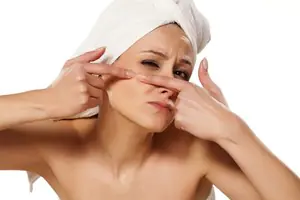
Acne on the face is a big problem for many people of completely different ages. It is commonly believed that only teenagers during puberty suffer from acne, but this is absolutely not true. Of course, a larger percentage of patients still fall into this age group, but some older boys and girls, women and men also face this problem and wonder how they can get rid of acne on their face. After all, the appearance of acne indicates problems in the body.
Causes of acne
Before you learn how to remove acne from your face, you need to understand the causes of the rash. The body thus signals about some changes or problems. Here are the main causes of acne on the face:
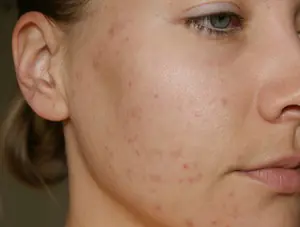
The period of adolescence - acne at this time is absolutely normal. With the onset of puberty, a hormonal surge occurs in the body, which is characterized by various changes and, sadly, skin rashes. Almost no teenager can avoid this.- Pregnancy period. Women who are pregnant have a very common rash. This is also due to hormonal changes.
- Hormonal crisis in infants.
- Endocrine problems in adults.
- Period of menstruation. Some women experience acne before their period. At the end of it, they disappear without treatment or any intervention.
- When using steroids. People who take steroids to improve their fitness are also at risk of developing acne.
- Various diseases of the genitourinary tract. A rash occurs in this situation mainly in men.
- Daily exposure or work with chemicals or cosmetics.
- Genetic predisposition.
- Intestinal problems. Improper diet and consumption of processed foods.
- Poor environment, dirty air and unhealthy lifestyle.
Treatment methods for rashes
To understand how to remove acne on the face, you must first know the cause of the rash and its severity. Depending on this, you can choose the necessary and most effective treatment method.
There are three main ways to treat acne on the face:

Cosmetological - practiced for the treatment of acne of the first and second severity. Basically, various scrubs, creams, lotions and cosmetic masks are used at this stage.- Treatment at home - also used to treat acne of the first degrees of severity as an alternative to ready-made factory products. A very common treatment method that is actively practiced in the 21st century.
- Medicinal method - used to treat acne of the third and fourth stages. In this case, antibiotics, various hormonal drugs, and medications are used to treat the disease that caused acne.
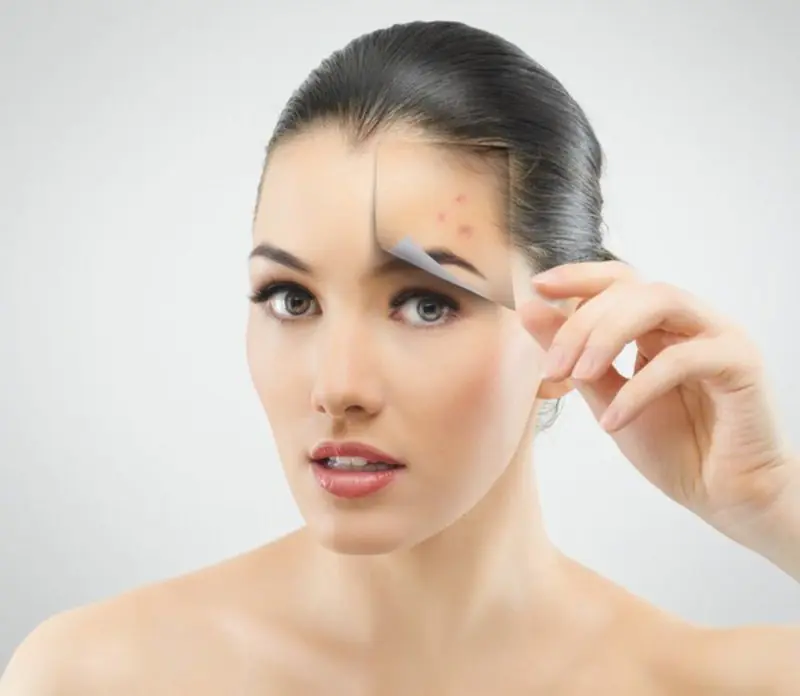
If the situation is critical and you cannot do without special medications, you need to contact your doctor, undergo the necessary examination and get tested. After this, the doctor will prescribe the truly correct and necessary treatment to remove acne on the face. Self-selection of drugs may be incorrect, it will only aggravate the situation or simply be useless.
Cosmetic intervention
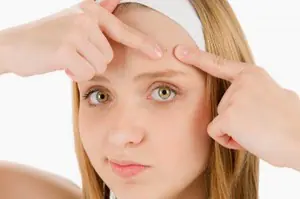
As for the cosmetological method, in this case it is also advisable to contact a specialist. An experienced cosmetologist will determine the cause and select the necessary product depending on your skin type and age. There are a lot of cosmetic preparations against acne. A specialist will help you decide and not harm your skin. A properly selected course can solve the problem of rashes much faster and more effectively.
Home treatment is more flexible and versatile. There are many recipes that will help get rid of acne at home; you can use any, choosing the most suitable one for yourself. Of course, we must not forget that there should be moderation in everything, and you should always pay attention to possible side effects. A new recipe should be tried gradually, carefully observing the result. If redness, peeling or other negative effects are observed on the skin of the cheeks and other areas of the face, treatment should be stopped immediately.
Traditional medicine recipes
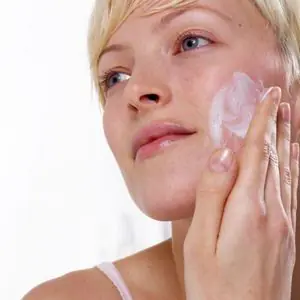
Getting rid of acne at home without going to cosmetologists and doctors is quite possible. Firstly, you definitely need to watch your diet. You should exclude simple carbohydrates from your diet: flour products, fatty foods and sweets. Secondly, actively monitor facial hygiene: keep your hands clean, wash your face regularly and thoroughly, use cleansers, and wash off makeup before going to bed.
Selecting acne treatments yourself is acceptable for those who want to remove acne at home. But only if the disease is not severe and does not require medical intervention.
Improper skin care increases the activity of the sebaceous glands, which also causes acne.
You can get rid of acne on your face using available means. Most common ingredients:
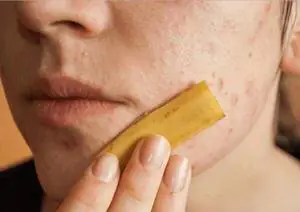
Chamomile infusion. Chamomile is considered to be the best antiseptic. Suitable for both oily skin and dry and combination skin. You can buy chamomile at any pharmacy. It's easy to use - you just need to brew it and wipe your skin with this infusion every two to three hours. There is also a stronger way to use it: brew chamomile and add 100 g of ethyl alcohol. Leave the resulting mixture to infuse for 24 hours, after which it can be used to wipe your face in the morning and evening.- Salicylic acid. A very effective product, but not recommended for use if the skin is overly sensitive. There are no other contraindications. The cotton wool should be slightly moistened in the solution and then wiped over the face. The procedure is repeated twice a day. The effect is visible within a few days. The procedure can be carried out for an unlimited amount of time.
- Calendula infusion. To use, you need to dilute it with boiled or purified water in a ratio of 50 to 50. Wipe your face in the morning, after standard procedures. The course of treatment is 14−21 days. Calendula will help not only get rid of acne, but also eliminate traces of it and tighten the skin.
- Application of garlic. Before this procedure, the face must be generously lubricated with olive oil or petroleum jelly to avoid burns. Then apply grated garlic evenly to the skin and leave for 8-10 minutes. Afterwards, rinse and apply moisturizer.
- Blue clay. With its help you can make excellent cleansing masks for problem areas (nose, lips, forehead). You just need to mix the clay with mineral water 50/50. Spread the resulting porridge on your face and leave until dry, then simply rinse with water. A mixture of blue clay and fruit puree is very good for acne. The puree is made from fresh fruits such as apples, strawberries and grapes. The principle of use and proportions are the same. After using the fruit mask, it is advisable to lubricate the skin with Vaseline ointment or any oil. You can also use a mask with milk. You need to put in about twice as much clay as milk, so that the mass is thicker. You need to apply it a little, the layer should be very thin. The mixture should be washed off after 15-20 minutes.
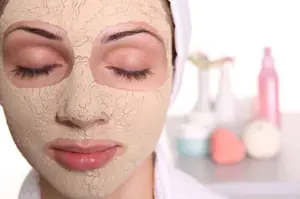
Bodyagi powder. The tool is famous for its simplicity and accessibility. To prepare the medicine, we need bodyaga (one packet) and chamomile decoction (you can use sage decoction or ordinary purified water). This mask helps get rid of whiteheads, and also helps smooth out wrinkles and unevenness on the skin of the face.- A very effective folk remedy to remove acne and acne is masks with honey. Used for pink or red acne. Recipe: mix 75 grams of honey with the same amount of olive oil. Add one yolk to the resulting mass and beat everything together. This remedy is used daily for 10−30 days. It all depends on the amount of inflammation. Once the desired result is achieved, the course can be completed. The honey mask also eliminates excessive oily skin, removes age spots and has a light, brightening effect.
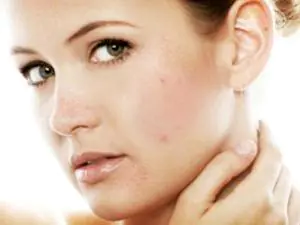
Mumiyo. Recommended for use by people with problematic combination skin. Helps fight in a short time not only with acne, drying them out, but also with old scars and other blemishes on the skin. To prepare this product, you need to take 2 teaspoons of mumiyo, any face cream (75 g) and tea tree oil (25 g). Next, you need to mix everything until smooth and leave on your face for no longer than thirty minutes. Should not be used every day. You should take a break of 24 hours between procedures.
Using folk remedies to treat acne is, of course, a little troublesome, but the results are obvious. It's no secret that with the help of traditional medicine you can cure almost any disease. But still, before trying a new recipe, you should conduct a small test for allergic reactions, because no one is immune from this.



